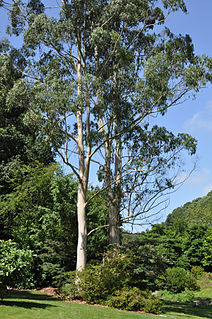
Eucalyptus dalrympleana, commonly known as mountain gum, mountain white gum, white gum and broad-leaved ribbon gum, is a species of tree that is endemic to southeastern Australia. It has smooth bark, lance-shaped adult leaves, flower buds in groups of three or seven, white flowers and cup-shaped, bell-shaped or hemispherical fruit.

Eucalyptus pulverulenta, commonly known as silver-leaved mountain gum, is a species of straggly tree or mallee that is endemic to southern New South Wales. It has smooth bark, egg-shaped, heart-shaped or round, sessile leaves arranged in opposite pairs, flower buds in groups of three, white flowers and cup-shaped to cylindrical fruit.

Eucalyptus rubida, commonly known as candlebark, ribbon gum or white gum, is a species of small to medium-sized tree that is endemic to south-eastern Australia. It has smooth bark, sometimes with rough bark at the base, lance-shaped or curved adult leaves, flower buds in groups of three, white flowers and cup-shaped, hemispherical or bell-shaped fruit.

Eucalyptus michaeliana, commonly known as Hillgrove gum or brittle gum, is a species of small to medium-sized tree that is endemic to eastern Australia. It has smooth mottled greyish bark, lance-shaped to curved adult leaves, flower buds in compound umbels, white flowers and cup-shaped or barrel-shaped fruit.

Eucalyptus camphora, commonly known as swamp gum is a flowering plant that is endemic to south-eastern Australia. It is a species of small to medium-sized tree with smooth bark, sometimes rough at the base, broadly lance-shaped to egg-shaped or elliptic adult leaves, flower buds in groups of seven, white flowers and conical fruit. There are two subspecies, subspecies camphora, commonly known as broad-leaved sally or swamp gum and subspecies humeana, commonly known as mountain swamp gum.

Eucalyptus albens, known as the white box, is a common tree of the western slopes and plains of New South Wales and adjacent areas in Queensland and Victoria. It has rough, fibrous bark on the base of its trunk and smooth, white bark above. The leaves are lance-shaped and groups of seven spindle-shaped flower buds are arranged in leaf axils or on the ends of the branches. White flowers are mostly present between August and February and the fruit are barrel-shaped to urn-shaped.

Eucalyptus blakelyi, known as Blakely's red gum, is a tree endemic to eastern Australia. It has smooth bark on its trunk and branches, dull bluish green, lance-shaped adult leaves, flower buds usually in groups of seven, white flowers and cup-shaped to hemispherical fruit.

Eucalyptus aggregata, commonly known as black gum, is a medium-sized tree that is endemic to southeastern Australia. It has rough, flaky bark, sometimes smooth on the branches, lance-shaped leaves, green to yellow flower buds in group of seven, white flowers and more or less cup-shaped fruit. It is a component of grassy woodland, often in low-lying or swampy areas, much of which has been cleared and it is under threat.

Eucalyptus badjensis, commonly known as the Big Badja gum, is a tree that is endemic to south-eastern New South Wales. It has hard, rough bark on the lower part of the trunk, smooth grey bark above, often hanging in strips on the upper branches, linear to narrow lance-shaped, often curved adult leaves, green to yellow buds in groups of three in leaf axils, white flowers and conical or bell-shaped fruit.

Eucalyptus parvula, commonly known as small-leaved gum, is a species of small tree that is endemic to south-eastern New South Wales. It has mostly smooth bark, elliptical to lance-shaped adult leaves but with many juvenile of intermediate leaves in the crown, flower buds in groups of seven, white flowers and cup-shaped fruit.

Eucalyptus kartzoffiana, commonly known as the Araluen gum, is a species of medium-sized tree that is endemic to a small area of southeastern New South Wales. It has rough, fibrous or flaky bark on part or most of its trunk, lance-shaped or curved adult leaves, flower buds in groups of three, white flowers and sessile, bell-shaped fruit.

Eucalyptus mannifera, commonly known as the brittle gum or red spotted gum, is a species of small to medium-sized tree that is endemic to south-eastern Australia. It has smooth, powdery white bark, lance-shaped to curved adult leaves, flower buds in groups of seven, white flowers and cup-shaped, hemispherical or conical fruit.

Eucalyptus benthamii, commonly known as Camden white gum, Bentham's gum, Nepean River gum, kayer-ro or durrum-by-ang, is a species of tree that is endemic to New South Wales. It has mostly smooth bluish grey or white bark, lance-shaped to curved adult leaves, flower buds arranged in groups of seven, white flowers and cup-shaped, bell-shaped or conical fruit.

Eucalyptus banksii, commonly known as the Tenterfield woollybutt, is a tree that is endemic to eastern Australia. It has rough fibrous or flaky bark, lance-shaped to curved leaves, flower buds without a pedicel in groups of seven in leaf axils, white flowers and hemispherical to cup-shaped or conical fruit.
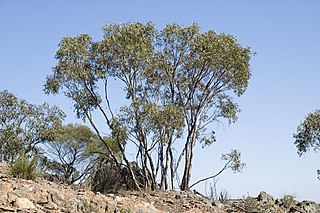
Eucalyptus dwyeri, commonly known as Dwyer's red gum or Dwyer's mallee gum, is a species of small tree, sometimes a mallee that is endemic to eastern Australia. It has smooth, white or cream-coloured bark, lance-shaped to curved adult leaves, flower buds in groups of seven and conical, bell-shaped or hemispherical fruit.
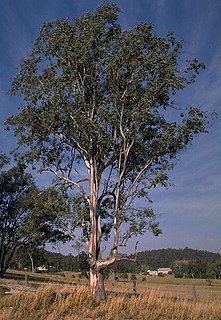
Eucalyptus glaucina, commonly known as the slaty red gum, is a species of small to medium-sized tree endemic to New South Wales. It has smooth, white and grey bark, lance-shaped adult leaves, flower buds in groups of seven, white flowers and hemispherical fruit with the valves protruding well above the level of the rim.

Eucalyptus prava, commonly known as orange gum, is a species of small to medium-sized tree that is endemic to eastern Australia. It has smooth, mottled bark, lance-shaped or curved adult leaves, flower buds in groups of seven, white flowers and cup-shaped or hemispherical fruit.
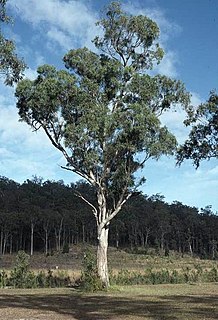
Eucalyptus seeana, or narrow-leaved red gum, is a species of small to medium-sized tree that is endemic to eastern Australia. It has smooth bark, lance-shaped adult leaves, flower buds in groups of between seven and eleven, white flowers and hemispherical fruit.

Eucalyptus bakeri, commonly known as Baker's mallee or the mallee box, is a eucalypt that is endemic to eastern Australia. It has fibrous bark on the trunk and smooth white or grey bark above, narrow lance-shaped leaves, flower buds in groups of between seven and thirteen, white flowers and hemispherical or shortened spherical fruit.
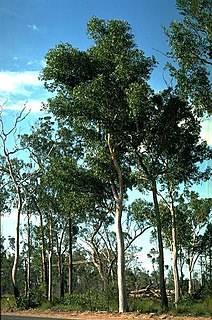
Eucalyptus hallii, commonly known as Goodwood gum, is a species of small to medium-sized tree that is endemic to Queensland. It has smooth bark, lance-shaped to curved adult leaves, flower buds in groups of seven, white flower and conical fruit.
























